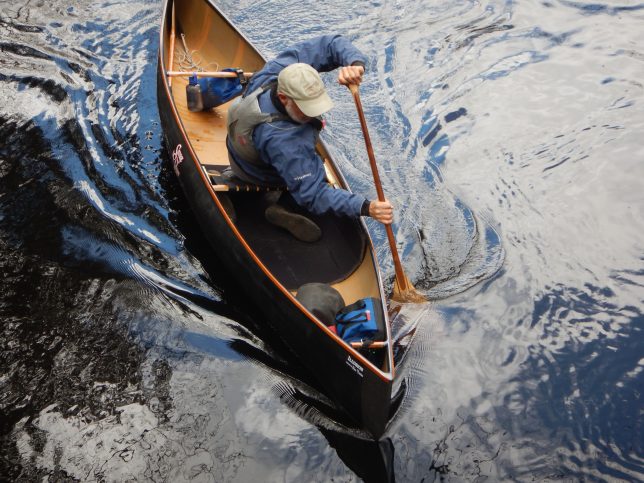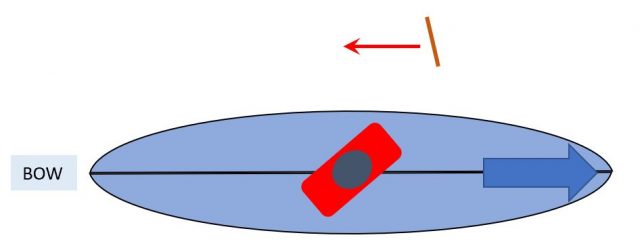by Marc Ornstein
In Part 1 of this series, we discussed the basic reverse stroke, reverse J and reverse sweep. In this article we’ll explore the far back and compound reverse strokes. Both of these strokes are far more powerful than the standard reverse stroke and provide a greater opportunity to look where you are going as opposed to seeing where you’ve been. The downside is that done properly, both require extreme torso rotation, the ability to do clean, in-water recoveries and other intricate paddle manipulations.
Let’s begin with the far back.
The paddler rotates his/her body, on the seat, approximately 45 deg. toward the on-side. Assuming a kneeling paddler, this requires the knees to be moved such that the onside knee is in the onside chine and the offside knee is between the center of the boat and the onside chine. Some paddlers manage both knees in the onside chine. The paddler’s torso is likewise rotated as far as possible toward the onside. If done correctly the shoulders should be nearly parallel to the keel line and it should be possible to rotate one’s head so as to face the stern.
Reaching back as far as possible the paddle is placed, blade fully or nearly submerged, grip hand out over the gunwale, shaft vertical, and blade perpendicular to the keel line. Placement is a couple of inches out from the gunwale allowing the stroke to be straight forward without following the curve of the canoe.
 |
The blade is then drawn forward, approximately to the hip, keeping the shaft vertical throughout. This is a very short stroke.
At the end of the stroke the grip hand is rotated 90 deg. so that the thumb points straight back and the blade is sliced through the water, back to the placement position for the next stroke.
 |
 |
| Although the ability to steer is limited with the far back, some is possible. Placement further away from the hull allows for a slight draw at the beginning. In fact, since the entire stroke takes place astern of the paddler, and behind the canoe’s center of rotation, pitching the blade so that the outer edge of the blade is angled a bit forward (compared to the inner edge), will cause the stern to be drawn toward the paddle side throughout. |  |
| Conversely, with a Placement tight to the hull and with the inner edge of the blade angled a bit forward (compared to the outer edge), the stern will be pried away from the paddle side throughout. Experiment and practice with draws, pries and pitch until you are able to steer while performing the far back. |  |
The advantages of the far back over the standard reverse stroke are twofold. One is that, properly done, it is more powerful. The pulling motion, with the torso fully “wound” is more powerful than the pushing motion of the standard reverse stroke. The second is the ability to face and see where you are going. Because of the limited ability to steer it’s best used when you don’t need to travel very far.
The compound reverse is as it sounds a combination of the standard reverse and the far back. I’d suggest practicing and becoming comfortable with both, before trying the compound.
Begin just as you would for the far back. Draw the blade forward to the hip, then, turn the grip thumb out (flipping the blade so that the power face becomes the back face) and continue moving the blade forward (you are now pushing the blade) to approximately your knee. (A reverse sweep or reverse J may be incorporated, if necessary, during this portion of the stroke.) This is the end of the stroke. Now, turn your thumb sternward and slice back to the catch position and repeat. Make certain that you keep your hands stacked, and the shaft nearly vertical throughout. It will take practice to cleanly execute the long slice back between strokes as well as the mid-stroke paddle “flip”. Note: Some folks find it easier to palm roll instead of flipping the blade, thus maintaining the same power face throughout the stroke.
Mastering the compound reverse will reward you with a useful tool that gives you the power of the far back plus the directional control of the standard reverse. It also allows you to easily see both where you are going and where you’ve just been.
Here are Videos showing the Compound Reverse stroke, in real time and 1/4 speed:
In the final installment of this three-part series, I’ll discuss cross reverse, my all time favorite way of backing up.